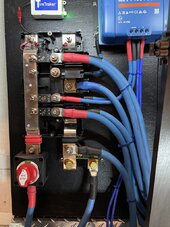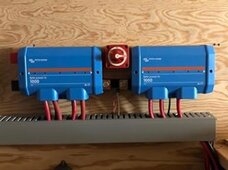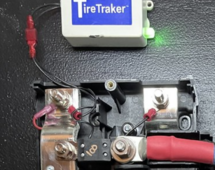So I read all the links that popped up regarding this and they are all for 12v and couple for 24v which if I read correctly from other posts 12v uses much thicker wire than 24v and 48v is even smaller. However, I want to be sure before I finish my battery and wire everything up.
I have the Victron 48/3000 inverter/charger. I am building a 48v 16s (Jehu Garcia battery/videos/etc) using the LEV60 72ah batteries. The BMS is 100a.
Internally I think Jehu's video was using 4awg but hard to tell and I did wire up some 4AWG in the bms/battery but MAN that stuff is difficult to bend around the small space. So I did order some 2 gauge welding/battery cable (copper, not CCA) which has a ton of tiny strands. I'd rather have "more" than worry about heating/fire/etc. Also appears 2AWG can handle up to 130amps, so I think it should be plenty for the internal of the battery.
Where I am a bit more hung up is on the cable AWG size to run from battery to the inverter. I actually sprung for the Lynx Distributor as I do want to add MPTT as well as another group of 48v batteries at some point (though I am unclear if I can add other brand batteries using the distributor to the same inverter/charger or if I need a separate inverter/charger and lynx distributor setup if I say.. build some 302ah battery kits).
Because the BMS is 100a, and the length from battery to the distributor, and then distributor to battery is only a couple feet each at most, I assume 2AWG is still enough for a 48v setup. The inverter puts out 3000w max.. which means a max of 25a on the AC OUT.. so I dont see why 2AWG wouldn't be enough if not overkill. As for charging the battery, presently I will only have a 15a AC IN (via 12awg plug) to charge it. Once I add MPTT and solar, maybe then if necessary I could wire up 2/0 if needed from inverter to battery?
So.. just wanted to quadruple check my assumption that a 2 AWG should be fine for my current uses which is 15a AC IN to charge, and at most 25A 3000watt output via AC OUT 1 (also on 12AWG plug).
Thanks.
I have the Victron 48/3000 inverter/charger. I am building a 48v 16s (Jehu Garcia battery/videos/etc) using the LEV60 72ah batteries. The BMS is 100a.
Internally I think Jehu's video was using 4awg but hard to tell and I did wire up some 4AWG in the bms/battery but MAN that stuff is difficult to bend around the small space. So I did order some 2 gauge welding/battery cable (copper, not CCA) which has a ton of tiny strands. I'd rather have "more" than worry about heating/fire/etc. Also appears 2AWG can handle up to 130amps, so I think it should be plenty for the internal of the battery.
Where I am a bit more hung up is on the cable AWG size to run from battery to the inverter. I actually sprung for the Lynx Distributor as I do want to add MPTT as well as another group of 48v batteries at some point (though I am unclear if I can add other brand batteries using the distributor to the same inverter/charger or if I need a separate inverter/charger and lynx distributor setup if I say.. build some 302ah battery kits).
Because the BMS is 100a, and the length from battery to the distributor, and then distributor to battery is only a couple feet each at most, I assume 2AWG is still enough for a 48v setup. The inverter puts out 3000w max.. which means a max of 25a on the AC OUT.. so I dont see why 2AWG wouldn't be enough if not overkill. As for charging the battery, presently I will only have a 15a AC IN (via 12awg plug) to charge it. Once I add MPTT and solar, maybe then if necessary I could wire up 2/0 if needed from inverter to battery?
So.. just wanted to quadruple check my assumption that a 2 AWG should be fine for my current uses which is 15a AC IN to charge, and at most 25A 3000watt output via AC OUT 1 (also on 12AWG plug).
Thanks.










